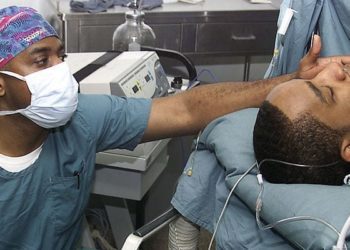Steep decline in atherosclerosis among US soldiers observed
 Dec 31st –
Dec 31st –  Study demonstrates a ~5 fold reduction in the rate of coronary atherosclerosis among current US service members in comparison to prior studies.
Study demonstrates a ~5 fold reduction in the rate of coronary atherosclerosis among current US service members in comparison to prior studies.
[tabs tab1=”2MM Rundown” tab2= “2MM Full Report” tab3=”About the Authors”]
[tab]
Image: PD
1. Rates of coronary atherosclerosis in US service members were last studied during the Korean and Vietnam Wars.
2. This study demonstrates a ~5 fold reduction in the rate of coronary atherosclerosis among current US service members in comparison to prior studies.
Results of this study estimate that the prevalence of coronary atherosclerosis in US service members is 8.5%, which would be dramatically decreased from a 1971 study which indicated a prevalence of 45%. However, there are several limitations. Foremost, there are several methodological differences (e.g. classifying atherosclerosis) that raise caution. Also, as there is no longer a military draft, there is a possible selection bias in considering the cardiovascular health of current US service members. Further, since the autopsies were performed by various pathologists over 10 years, interobserver variation based on different pathologists is a distinct possibility. While one can argue that an actual dramatic decrease in atherosclerosis prevalence among military personnel may account for the results of the study, the limitations should be considered very carefully. Future directions for this research include follow up studies at regular intervals to better measure the effects of lifestyle modifications, such as smoking cessation and diet changes, on the prevalence of atherosclerosis.
Click to read the study in JAMA
Click to read accompanying editorial in JAMA
[/tab]
[tab]
Image: PD
1. Rates of coronary atherosclerosis in US service members were last studied during the Korean and Vietnam Wars.
2. This study demonstrates a ~5 fold reduction in the rate of coronary atherosclerosis among current US service members in comparison to prior studies.
Study author, Dr. Bryant Webber talks to 2 Minute Medicine: Uniformed Services University of the Health Sciences, Bethesda, Maryland
“As expected, the prevalence of atherosclerosis at autopsy varies based on age, education, and the presence or absence of major cardiovascular risk factors, such as hypertension and obesity. Nonetheless, even young and healthy people–military personnel fit enough to deploy into combat–are susceptible to coronary atherosclerosis, the precursor of ischemic heart disease. Although the US military has made great progress since the Korean and Vietnam war eras, and although similar downward trends have been seen in the general US population, cardiovascular disease remains the leading case of death in many developed nations. Military and civilian health care systems should continue to help their patients prevent disease by living a healthy lifestyle and reducing their cardiovascular risk factors. At the population level, we should be innovative in discouraging smoking, promoting healthy eating and physical activity, helping people manage their weight, and making the healthy choice the easiest choice.”
Primer: Over the past century the leading cause of death has transformed from infectious diseases, such as pneumonia, tuberculosis, and diarrhea, to the current epidemic of heart disease. Explanations for this change include improvements in ability to treat infectious disease and in diagnostic technologies, along with the population’s increased life expectancy. While such improvements in healthcare allow for increased longevity, they are simultaneously allowing more time for heart disease to manifest itself. To measure the prevalence of subclinical coronary atherosclerosis in our youth, autopsy studies have been conducted on US service members. The first such study, in 1953, recorded a 77% prevalence in Korean War soldiers. The second, in 1971, recorded a 45% prevalence in Vietnam soldiers. These studies, while conducted on small sample sizes, revealed an epidemic of subclinical heart disease in our country. The authors of this study wished to assess the current prevalence of atherosclerosis in US service members who died in combat.
Background reading:
1. Coronary atherosclerosis in Korean War soldiers.
2. Coronary atherosclerosis in Vietnam War soldiers.
This [cross-sectional study]: The study examined 3,832 autopsy reports of US service members who died in support of Operation Enduring Freedom or Operation Iraqi Freedom/New Dawn between October 2001 and August 2011. Service members were aged 18-59 and 98.3% male. The primary outcome measured was prevalence of coronary atherosclerosis in US service members. This was determined to be 8.5% (95% CI, 7.6%-9.4%).
Increased prevalence of coronary atherosclerosis showed the strongest association with age >30. Statistically significant associations were also made with education level that was not exceeding high school and military entrance with a BMI >25. Prior diagnoses of dyslipidemia, obesity, or hypertension were also associated with increased prevalence of coronary atherosclerosis.
In sum: Results of this study estimate that the prevalence of coronary atherosclerosis in US service members is 8.5%, which would be dramatically decreased from a 1971 study which indicated a prevalence of 45%. However, there are several limitations. Foremost, there are several methodological differences (e.g. classifying atherosclerosis) that raise caution. Also, as there is no longer a military draft, there is a possible selection bias in considering the cardiovascular health of current US service members. Further, since the autopsies were performed by various pathologists over 10 years, interobserver variation based on different pathologists is a distinct possibility. While one can argue that an actual dramatic decrease in atherosclerosis prevalence among military personnel may account for the results of the study, the limitations should be considered very carefully. Future directions for this research include follow up studies at regular intervals to better measure the effects of lifestyle modifications, such as smoking cessation and diet changes, on the prevalence of atherosclerosis.
Click to read the study in JAMA
Click to read accompanying editorial in JAMA
More from this author: Protected sleep periods improve intern alertness and sleep duration, ADHD medication decreases rates of criminality in ADHD patients, Low dose aspirin shows net clinical benefit in patients with first unprovoked venous thromboembolism
Written by [JP] and [RR]
© 2012 2minutemedicine.com. All rights reserved. No works may be reproduced without written consent from 2minutemedicine.com. Disclaimer: We present factual information directly from peer reviewed medical journals. No post should be construed as medical advice and is not intended as such by the authors or by 2minutemedicine.com. PLEASE SEE A HEALTHCARE PROVIDER IN YOUR AREA IF YOU SEEK MEDICAL ADVICE OF ANY SORT. Content is produced in accordance with fair use copyrights solely and strictly for the purpose of teaching, news and criticism. No benefit, monetary or otherwise, is realized by any participants or the owner of this domain.
[/tab]
[tab]

John Prendergass: John is a 2nd year M.D. candidate at New Jersey Medical School. He was raised in Jersey City, NJ and attended Johns Hopkins University for his undergraduate degree in Behavioral Biology. His academic interests include general surgery, neuroscience, and pediatrics. Outside of school John enjoys basketball and soccer.
 Rif Rahman: Rif is a 4th year M.D. candidate at Harvard Medical School, currently completing a research year investigating the use of conventional and advanced imaging techniques to assess treatment response of high grade gliomas. His medical interests are in the areas of internal medicine and neurology.
Rif Rahman: Rif is a 4th year M.D. candidate at Harvard Medical School, currently completing a research year investigating the use of conventional and advanced imaging techniques to assess treatment response of high grade gliomas. His medical interests are in the areas of internal medicine and neurology.
[/tab]
[/tabs]







